玛氏面试案例分析培训(Case interview)
玛氏面试
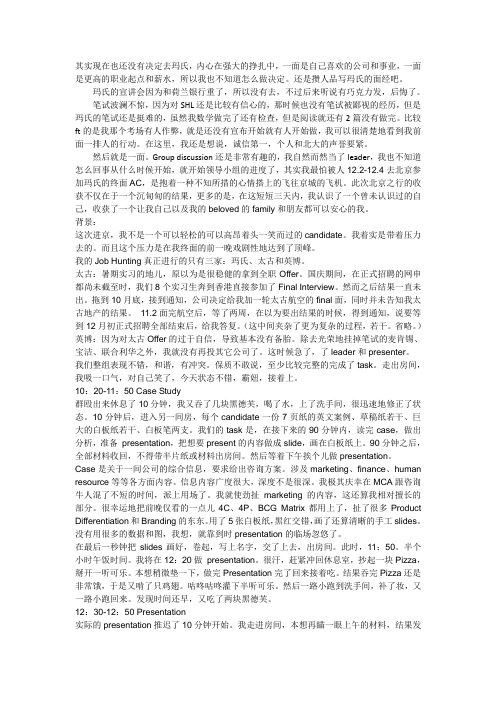
其实现在也还没有决定去玛氏,内心在强大的挣扎中,一面是自己喜欢的公司和事业,一面是更高的职业起点和薪水,所以我也不知道怎么做决定。
还是攒人品写玛氏的面经吧。
玛氏的宣讲会因为和荷兰银行重了,所以没有去,不过后来听说有巧克力发,后悔了。
笔试波澜不惊,因为对SHL还是比较有信心的,那时候也没有笔试被鄙视的经历,但是玛氏的笔试还是挺难的,虽然我数学做完了还有检查,但是阅读就还有2篇没有做完。
比较ft的是我那个考场有人作弊,就是还没有宣布开始就有人开始做,我可以很清楚地看到我前面一排人的行动。
在这里,我还是想说,诚信第一,个人和北大的声誉要紧。
然后就是一面。
Group discussion还是非常有趣的,我自然而然当了leader,我也不知道怎么回事从什么时候开始,就开始领导小组的进度了,其实我最怕被人12.2-12.4去北京参加玛氏的终面AC,是抱着一种不知所措的心情搭上的飞往京城的飞机。
此次北京之行的收获不仅在于一个沉甸甸的结果,更多的是,在这短短三天内,我认识了一个曾未认识过的自己,收获了一个让我自己以及我的beloved的family和朋友都可以安心的我。
背景:这次进京,我不是一个可以轻松的可以高昂着头一笑而过的candidate。
我着实是带着压力去的。
而且这个压力是在我终面的前一晚戏剧性地达到了顶峰。
我的Job Hunting真正进行的只有三家:玛氏、太古和英博。
太古:暑期实习的地儿,原以为是很稳健的拿到全职Offer。
国庆期间,在正式招聘的网申都尚未截至时,我们8个实习生奔到香港直接参加了Final Interview。
然而之后结果一直未出。
拖到10月底,接到通知,公司决定给我加一轮太古航空的final面,同时并未告知我太古地产的结果。
11.2面完航空后,等了两周,在以为要出结果的时候,得到通知,说要等到12月初正式招聘全部结束后,给我答复。
(这中间夹杂了更为复杂的过程,若干。
省略。
)英博:因为对太古Offer的过于自信,导致基本没有备胎。
玛氏面试案例分析题
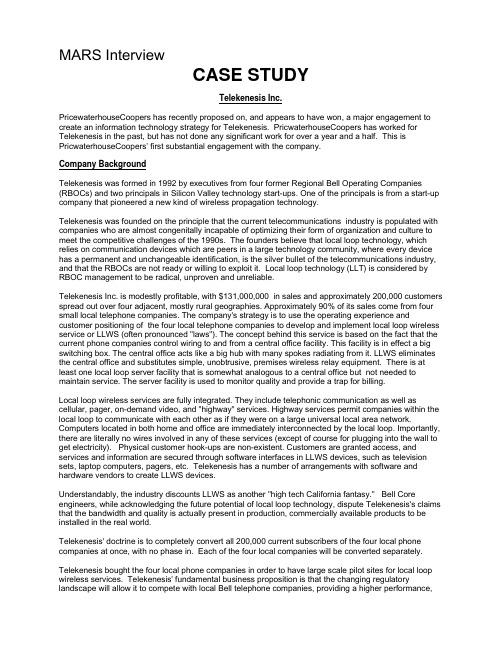
MARS InterviewCASE STUDYTelekenesis Inc.PricewaterhouseCoopers has recently proposed on, and appears to have won, a major engagement to create an information technology strategy for Telekenesis. PricwaterhouseCoopers has worked for Telekenesis in the past, but has not done any significant work for over a year and a half. This is PricwaterhouseCoopers’ first substantial engagement with the company.Company BackgroundTelekenesis was formed in 1992 by executives from four former Regional Bell Operating Companies (RBOCs) and two principals in Silicon Valley technology start-ups. One of the principals is from a start-up company that pioneered a new kind of wireless propagation technology.Telekenesis was founded on the principle that the current telecommunications industry is populated with companies who are almost congenitally incapable of optimizing their form of organization and culture to meet the competitive challenges of the 1990s. The founders believe that local loop technology, which relies on communication devices which are peers in a large technology community, where every device has a permanent and unchangeable identification, is the silver bullet of the telecommunications industry, and that the RBOCs are not ready or willing to exploit it. Local loop technology (LLT) is considered by RBOC management to be radical, unproven and unreliable.Telekenesis Inc. is modestly profitable, with $131,000,000 in sales and approximately 200,000 customers spread out over four adjacent, mostly rural geographies. Approximately 90% of its sales come from four small local telephone companies. The company's strategy is to use the operating experience and customer positioning of the four local telephone companies to develop and implement local loop wireless service or LLWS (often pronounced "laws"). The concept behind this service is based on the fact that the current phone companies control wiring to and from a central office facility. This facility is in effect a big switching box. The central office acts like a big hub with many spokes radiating from it. LLWS eliminates the central office and substitutes simple, unobtrusive, premises wireless relay equipment. There is at least one local loop server facility that is somewhat analogous to a central office but not needed to maintain service. The server facility is used to monitor quality and provide a trap for billing.Local loop wireless services are fully integrated. They include telephonic communication as well as cellular, pager, on-demand video, and "highway" services. Highway services permit companies within the local loop to communicate with each other as if they were on a large universal local area network. Computers located in both home and office are immediately interconnected by the local loop. Importantly, there are literally no wires involved in any of these services (except of course for plugging into the wall to get electricity). Physical customer hook-ups are non-existent. Customers are granted access, and services and information are secured through software interfaces in LLWS devices, such as television sets, laptop computers, pagers, etc. Telekenesis has a number of arrangements with software and hardware vendors to create LLWS devices.Understandably, the industry discounts LLWS as another "high tech California fantasy." Bell Core engineers, while acknowledging the future potential of local loop technology, dispute Telekenesis's claims that the bandwidth and quality is actually present in production, commercially available products to be installed in the real world.Telekenesis' doctrine is to completely convert all 200,000 current subscribers of the four local phone companies at once, with no phase in. Each of the four local companies will be converted separately. Telekenesis bought the four local phone companies in order to have large scale pilot sites for local loop wireless services. Telekenesis' fundamental business proposition is that the changing regulatory landscape will allow it to compete with local Bell telephone companies, providing a higher performance,lower cost alternative to the existing local phone companies for local and long-distance telephone service, paging, cable t.v., and cellular phones.Industry TrendsThe early 1980s were a time of turmoil for the telecommunications industry. For the first time in history, AT&T was deregulated and lost its monopoly status. This meant competition for AT&T where none had existed before. Long-distance was the arena of competition."Telecommunications" includes much more than simply making a phone-call. It encompasses cable television service and network connectivity which brings interactive television, shopping forums, education and information services into the home. The phone lines that the telecommunications companies control enable computers to communicate from remote locations, and can gather information from databases and news services around the world within seconds.The possibilities for profits in this arena are practically limitless, and the sphere of competition is expanding. Up to 1994, only long-distance carriers were in competition, but local calling areas are going to be opened up for competition in the late 1990s.Telekenesis OrganizationThere are currently three business units: 1) residential, which is divided into the "plain vanilla" customers that have only one phone line into the house and no add-ons such as cellular phones, pagers, additional lines, etc. and 2) residential customers who have add-on services and are good candidates for taking advantage of the new technology; and 3) small business. Each of Telekenesis's business units has a President who reports to the CEO. In addition, R&D and Technology Assurance, essentially a quality management program, also report directly to the CEO. Telekenesis is tightly controlled by the principals who founded the company and all the senior positions just described are held by the founders.There are really no Corporate functional areas such as Finance, Purchasing, Distribution, and Human Resources. These functions exist in the original phone companies as they did before the companies were acquired. An outsider with the title of Chief Financial Officer runs the Corporate functional area. She had a brief tenure as the CFO of an RBOC. The Technology Assurance Group helps support the existing communications and networking infrastructure.Telekenesis Current SituationPricewaterhouseCoopers was retained because of their knowledge of the RBOCs and an audit relationship with the four local phone companies. They were retained by Telekenesis for special start-up services, legal and regulatory counsel and assistance in dealing with obtaining additional venture capital financing. Because of the technology nature of Telekenesis, the PricwaterhouseCoopers Financial Advisory Services partner contacted IT Strategic Services. The Firm has now been asked to deal with the operational dimensions of Telekenesis as it commences detailed tactical planning for LLWS activation. Another management consulting firm is providing some business strategy consulting to Telekenesis. PricewaterhouseCoopers has been asked to propose on three major stages of work: 1) process vision; 2) tactical doctrine; 3) infrastructure and value. These are meant to give Telekenesis "process efficacy." This is their language.The current company is, in effect, the combination of the four small southern telephone companies that were acquired and are now operated by Telekenesis. However, except for top management, the vast majority of employees of the telephone companies were retained, as were the administrative and operational support systems. Some of those employees are very excited to be able to participate in this opportunity, but a lot of the old timers are dubious and apprehensive.All telephone company processes and functions are essentially the same as before the acquisition by Telekenesis. Telekenesis concentrated on establishing a simple, "no frills" system for collecting financialand operating information on the telephone companies but did virtually nothing to change the actual operations of the companies.Marley and Cratchet (the two silicon valley entrepreneurs) expect that the consultant selected will be able to bring fresh creative ideas to the process of what they term is "...creating a 21st Century company for a 21st Century business." Included in their definition of process efficacy is the notion of "enterprise extensibility," or put more simply put the capability to seamless team with external suppliers in a variety of value-adding, integrative relationships that can be episodic or persistent. Particularly important is the aspect of Telekenesis strategy in which vendors will provide LLWS compatible devices to customers who will pay a one-time $15 fee for the equipment.All four Telekenesis executives expect that the process efficacy initiatives will include information systems and technology strategy and planning. They want the consultant to provide a guaranteed "operational profile" that states that the recommended configuration of hardware and software, costing $xx and operational by 19yy will be able to support the local loop wireless service business.There are four distinct flavours of legacy systems across the four companies. Hardware and software is different, with three of the companies having an IBM mainframe in addition to other computers. Telekenesis installed IMRS on a high end x486 computer to provide financial consolidation and reporting of the four companies. Spreadsheet disks prepared at month end are FedExed to Telekenesis home office in Bernardsville, New Jersey and loaded into IMRS.Questions:Do you believe you have enough information to develop an Business/IT strategy for this client? If no, what additional information would you require?What skills would the consulting team need to successfully complete this engagement?How would you structure the work for this engagement?What are the risks that Telekenesis faces?What types of business processes will be needed?How would you integrate the processes of the four existing local phone companies and Telekenesis?。
玛氏面试资料大全(30页)
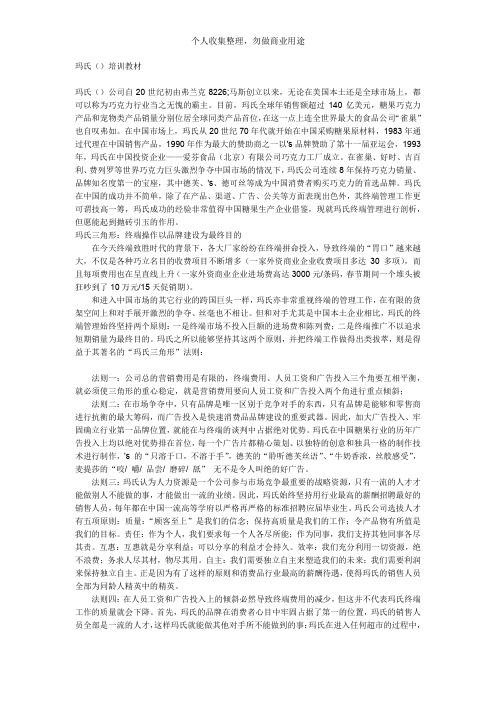
玛氏()培训教材玛氏()公司自20世纪初由弗兰克8226;马斯创立以来,无论在美国本土还是全球市场上,都可以称为巧克力行业当之无愧的霸主。
目前,玛氏全球年销售额超过140亿美元,糖果巧克力产品和宠物类产品销量分别位居全球同类产品首位,在这一点上连全世界最大的食品公司“雀巢”也自叹弗如。
在中国市场上,玛氏从20世纪70年代就开始在中国采购糖果原材料,1983年通过代理在中国销售产品,1990年作为最大的赞助商之一以's品牌赞助了第十一届亚运会,1993年,玛氏在中国投资企业——爱芬食品(北京)有限公司巧克力工厂成立。
在雀巢、好时、吉百利、费列罗等世界巧克力巨头激烈争夺中国市场的情况下,玛氏公司连续8年保持巧克力销量、品牌知名度第一的宝座,其中德芙、's、德可丝等成为中国消费者购买巧克力的首选品牌。
玛氏在中国的成功并不简单,除了在产品、渠道、广告、公关等方面表现出色外,其终端管理工作更可谓技高一筹,玛氏成功的经验非常值得中国糖果生产企业借鉴,现就玛氏终端管理进行剖析,但愿能起到抛砖引玉的作用。
玛氏三角形:终端操作以品牌建设为最终目的在今天终端致胜时代的背景下,各大厂家纷纷在终端拼命投入,导致终端的“胃口”越来越大,不仅是各种巧立名目的收费项目不断增多(一家外资商业企业收费项目多达30多项),而且每项费用也在呈直线上升(一家外资商业企业进场费高达3000元/条码,春节期间一个堆头被狂吵到了10万元/15天促销期)。
和进入中国市场的其它行业的跨国巨头一样,玛氏亦非常重视终端的管理工作,在有限的货架空间上和对手展开激烈的争夺、丝毫也不相让。
但和对手尤其是中国本土企业相比,玛氏的终端管理始终坚持两个原则:一是终端市场不投入巨额的进场费和陈列费;二是终端推广不以追求短期销量为最终目的。
玛氏之所以能够坚持其这两个原则,并把终端工作做得出类拔萃,则是得益于其著名的“玛氏三角形”法则:法则一:公司总的营销费用是有限的,终端费用、人员工资和广告投入三个角要互相平衡,就必须使三角形的重心稳定,就是营销费用要向人员工资和广告投入两个角进行重点倾斜;法则二:在市场争夺中,只有品牌是唯一区别于竞争对手的东西,只有品牌是能够和零售商进行抗衡的最大筹码,而广告投入是快速消费品品牌建设的重要武器。
玛氏面试题目加经验

【一面】迷迷糊糊在笔试过了很久之后收到了一面的通知。
一面就是群面啦。
六个人一个小组。
take it easy。
英文材料题,然后中文讨论,中文展示,写在白板上面。
时间不够的话,可以几个人一起分开写。
所以一般难度不大。
本人四六级低空飞过,但是英文材料里面的词基本都懂。
就是拼在一起有点不懂而已。
哈哈!所以,这个时候如果组里有个学外语的,真心爽!材料说的是一间啤酒厂在面临着种种危机与转机,然后让我们为这个啤酒厂制定明年的计划之类的。
突然发觉4P原则好实用。
我们组就是因为有会英语的,然后又有会4P原则的。
所以基本框架都不错。
然后我们组里有三个人进了二面。
这是本人第一次没有在一面群面的时候被刷的。
因为,俗话说,不怕神一样的对手,就怕猪一样的队友。
所以我真的很感激能够在一面的时候让我遇到不错的队友。
然后可以让我过了极容易坑我的一面。
【二面】时间大概一个人为半个小时以上吧。
我比较爱说话,二面面了将近一个小时。
囧。
大概也是因为HR的缘故。
而我二面中最后一个面试的,面试完已经十二点了。
我知道HR姐姐都很疲惫了。
所以到了让我提问环节的时候,我竟然问了一个很BT的问题。
我问HR姐姐,“在整个二面过程中谁给你留下最深刻的印象”然后HR姐姐含糊其辞了。
我以为我要因为这个被刷了。
结果面完不久就收到短信通知下午三面了。
二面刚才在上面网申环节有说到一下下。
就是针对你的简历提问问题。
而且,HR真的很会打破沙锅问到底啊啊啊啊啊啊!我都差点被问到木有底气了,但是我全程还是保持笑容。
谁叫我爱笑呢。
这个环节啊,还真的是很靠个人能力的。
记得要真诚待人啊!细节决定成败!!【三面】很意外地,竟然收到了三面通知。
三面就是传说中的摆货架。
貌似是有三分钟审题时间。
所谓审题,就是摆货架的背景和要求。
然后有20分钟(额,貌似是25分钟?不好意思,我记忆力差)讨论怎么摆。
然后就是1分钟将箱子里的产品拿出来,记得多拿点。
剩下就是5分钟让我们摆货架。
这个过程,记得大家都要动手。
玛氏面试感受分享南京大学小百合站
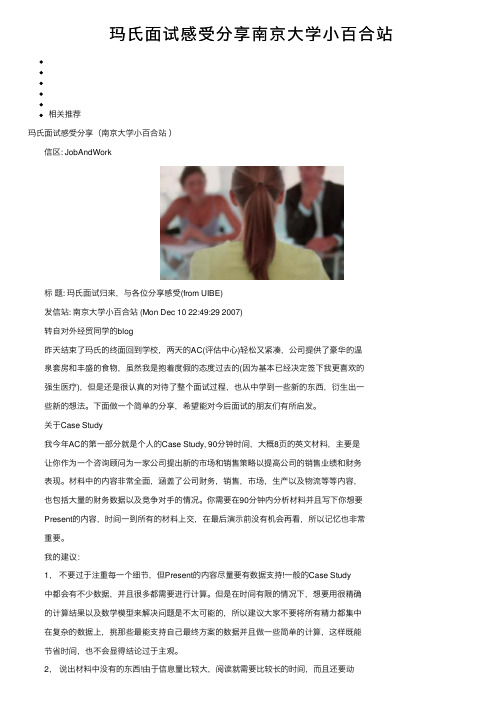
玛⽒⾯试感受分享南京⼤学⼩百合站相关推荐玛⽒⾯试感受分享(南京⼤学⼩百合站) 信区: JobAndWork 标题: 玛⽒⾯试归来,与各位分享感受(from UIBE) 发信站: 南京⼤学⼩百合站 (Mon Dec 10 22:49:29 2007) 转⾃对外经贸同学的blog 昨天结束了玛⽒的终⾯回到学校,两天的AC(评估中⼼)轻松⼜紧凑,公司提供了豪华的温 泉套房和丰盛的⾷物,虽然我是抱着度假的态度过去的(因为基本已经决定签下我更喜欢的 强⽣医疗),但是还是很认真的对待了整个⾯试过程,也从中学到⼀些新的东西,衍⽣出⼀ 些新的想法。
下⾯做⼀个简单的分享,希望能对今后⾯试的朋友们有所启发。
关于Case Study 我今年AC的第⼀部分就是个⼈的Case Study, 90分钟时间,⼤概8页的英⽂材料,主要是 让你作为⼀个咨询顾问为⼀家公司提出新的市场和销售策略以提⾼公司的销售业绩和财务 表现。
材料中的内容⾮常全⾯,涵盖了公司财务,销售,市场,⽣产以及物流等等内容, 也包括⼤量的财务数据以及竞争对⼿的情况。
你需要在90分钟内分析材料并且写下你想要 Present的内容,时间⼀到所有的材料上交,在最后演⽰前没有机会再看,所以记忆也⾮常 重要。
我的建议: 1,不要过于注重每⼀个细节,但Present的内容尽量要有数据⽀持!⼀般的Case Study 中都会有不少数据,并且很多都需要进⾏计算。
但是在时间有限的情况下,想要⽤很精确 的计算结果以及数学模型来解决问题是不太可能的,所以建议⼤家不要将所有精⼒都集中 在复杂的数据上,挑那些最能⽀持⾃⼰最终⽅案的数据并且做⼀些简单的计算,这样既能 节省时间,也不会显得结论过于主观。
2,说出材料中没有的东西!由于信息量⽐较⼤,阅读就需要⽐较长的时间,⽽且还要动 笔写,所以留给我们分析的时间并不多。
但分析的过程在我看来最为重要。
⾯试官希望听 到材料中没有的`东西,希望听到新的⽅案和观点,⽽不是对于材料内容的总结和概括。
玛氏面试案例分析题及答案

MARS Interview(Case Study section)Case 1: Coffee ShopThe ProblemA friend asked me if I wanted to buy his coffee shop for $100,000. Do you think I should do it?Information GatheringRead this information well before you give the case. Share this information in each bulletonly if the candidate asks for it in a clear and deliberate way. Location: The coffee shop is in Vail, ColoradoProducts/Prices:Cup of coffee, $4.00Bottled Water, $2.00Pastries, $3.00Variable Cost:All products have a 50% marginCustomers:The shop serves mostly locals, not tourists, so demand is consistent throughout the yearOther Costs:Rent was $500 per monthWages (for 2 employees) were $8.00 per hour.The shop is open 12 hours a day, six days a weekTell the candidate that he can assume that the coffee shop will bring in consistent profits.AnalysisThis is a valuation question. So to get the value of the coffee shop we need first to get theprofitability.RevenuesEstimate market size.Assume that the coffee shop gets 10 customers per hour in slow hour and 20 customersper hour in a busy hour. The first and last 2 hours of the day are busy hours. So the coffeeshop gets 20x4 + 10x8 = 160 customers/day.If we assume all the hours as busy hours on Saturday, then we have 20x12=240 hours on Saturday.Number of customers / week = 160 x 5 + 240 x 1 = 1040Number of customers / year = 1040 x 50 = 50,200Assume 60% of customers order coffee, 30% order pastry, and 10% order a bottle of water, then the spend is:50,000 x 60% x 4 + 50,000 x 30% x 3 + 50,000 x 10% x 2 = $175,000Fixed CostsRent = 500 x 12 = $6,000Wages = $8 x 12 x 6 x 50 = $30,000We can also make assumptions about utilities and insurance.ProfitsProfits = 175,000 x 50% - 36,000 = $52,500Assume a 40% tax rate:Profits after tax = 52,500 x (1-40%) = $31,500ValuationIf we assume that the coffee shop is in operation for 5 years and we use a 10% WACC, then its value would be:Value = 31,500 + 31,500/ 1.1 + 31,500/1.1^2 + 31,500/1.1^3 + 31,500/1.1^4 = $131,000ConclusionAs long as the sales would be consistent for the rest of the 5 years, it would be profitable to buy the coffee shop. Further analysis could be done on the management experience and the competition to ensure that sales would be consistent.Case 2: HEALTHThe ProblemA US health care provider suffered a profit decline last year. You are hired to solve this problem.Information GatheringRead this information well before you give the case. Basic information shouldbe given as the candidate asks for it, but the rest of the interview is very directive. The candidate is supposed to follow the direction and do the math confidently. The interview style is pleasant and helpful.Background Information• The key revenues come from commissions.• H Health signs contracts with patients and provides medical services.• H Health has 300 contracted physicians.• A “referral” is necessary if certain medical treatment/service can’t be provided by Health’s contracted physicians.Question 1: How would you approach this problem?Answer:Profit = Revenue – Cost= No. of patients * (unit price – variable cost) – fixed costThe candidate can be creative to come up with possible reasons for revenue decrease andcost increase. Some examples –Revenue declined:-number of patients dropped-unit price dropped-competition grew their market shareCost increased:-VC: number of visits increased (e.g. major flu), per person cost increased (e.g. cost ofthe medicine), referral cost increased-FC: physician’s salary increasedQuestion 2: Competitor analysis – why is our referral cost higher than the competitor?H Health SunshineNumber of patients 300,000 500,000Referral cost $20 (per member, per month) $15 (same)Answer: (again, the candidate is encouraged to be creative)- Economies of scale- Lower administration costs-More contracted physiciansQuestion 3: Assuming none of the contracted physicians have the specialty of cardiology, estimate the number of referrals per year for cardiology based on thefollowing information:Number of patients: 300,00020% of the total population is > 65 years old, and 30% of them need treatmentFor the rest of the population, there’s a 10% chance for them to require the treatmentThe treatment usually requires 5 visits to the doctor per year.Answer:>65 years = 300,000*0.2*0.3 = 18,000<65 years = 300,000*0.8*0.1 = 24,00042,000*5 times/year = 210,000 (times/year)Question 4: The actual number of referrals is 300,000. Why is it higher than the estimate?Answer:population-They underestimated the number of visits per year-More demanding patients ask to be referred even if they don’t have such issues-Physicians refer non-cardiology patients because they don’t want to take the risk and are not motivated to provide services even if they are capable Question 5: How much does the number of referrals have to decrease in order to justify following incentive plan to encourage contracted physicians to be more responsible?Incentive plan:Bonus: $100,000 / year to top 10 physicians with the lowest referral rate Training: $1,000,000Referral cost: $200 per referralCurrent no. of referral: 300,000Answer:Total cost = 2,000,0002,000,000/200 = 10,000Question 6: If the incentive plan can reduce the number of referrals by 5% for yearone and 2% for year two, what is the total saving?Answer:Y1 = 300,000*5% = 15,000Y2 = (300,000 – 15,000)*2% = 5,700Total saving = (15,000 + 5,700)*$200 - $2,000,000*2 = $140,000Question 7: Apart from Cardiology, how can H Health improve the number of referrals in general?Answer:-Increase training to improve physician’s capability-Extend the incentive program to other departments-Improve the quality of relationship with the patients and build up the trust-Improve/remove physicians who are outliers with extremely high referral rate -Increase the no. of contracted physicians-Partner with other health care provider to lower referral costConclusionAccording to the example of cardiology, H Health should improve its profitability by lowering the referral cost. H Health can• reduce the number of referrals, and/or• reduce the cost per referral。
咨询业面试必看 case interview 及其经典案例分析
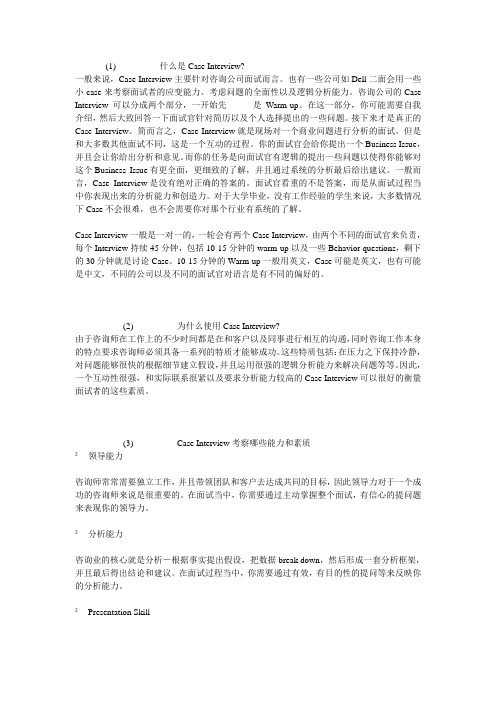
(1) 什么是Case Interview?一般来说,Case Interview主要针对咨询公司面试而言。
也有一些公司如Dell二面会用一些小case来考察面试者的应变能力、考虑问题的全面性以及逻辑分析能力。
咨询公司的Case Interview可以分成两个部分,一开始先是Warm-up。
在这一部分,你可能需要自我介绍,然后大致回答一下面试官针对简历以及个人选择提出的一些问题。
接下来才是真正的Case Interview。
简而言之,Case Interview就是现场对一个商业问题进行分析的面试。
但是和大多数其他面试不同,这是一个互动的过程。
你的面试官会给你提出一个Business Issue,并且会让你给出分析和意见。
而你的任务是向面试官有逻辑的提出一些问题以使得你能够对这个Business Issue有更全面,更细致的了解,并且通过系统的分析最后给出建议。
一般而言,Case Interview是没有绝对正确的答案的。
面试官看重的不是答案,而是从面试过程当中你表现出来的分析能力和创造力。
对于大学毕业,没有工作经验的学生来说,大多数情况下Case不会很难,也不会需要你对那个行业有系统的了解。
Case Interview一般是一对一的,一轮会有两个Case Interview,由两个不同的面试官来负责,每个Interview持续45分钟,包括10-15分钟的warm-up以及一些Behavior questions,剩下的30分钟就是讨论Case。
10-15分钟的Warm-up一般用英文,Case可能是英文,也有可能是中文,不同的公司以及不同的面试官对语言是有不同的偏好的。
(2) 为什么使用Case Interview?由于咨询师在工作上的不少时间都是在和客户以及同事进行相互的沟通,同时咨询工作本身的特点要求咨询师必须具备一系列的特质才能够成功。
这些特质包括:在压力之下保持冷静,对问题能够很快的根据细节建立假设,并且运用很强的逻辑分析能力来解决问题等等。
玛氏面试培训题目-开放性问题
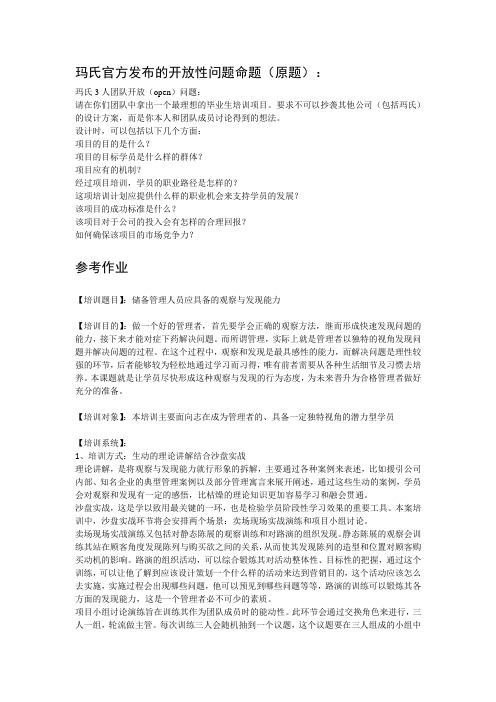
玛氏官方发布的开放性问题命题(原题):玛氏3人团队开放(open)问题:请在你们团队中拿出一个最理想的毕业生培训项目。
要求不可以抄袭其他公司(包括玛氏)的设计方案,而是你本人和团队成员讨论得到的想法。
设计时,可以包括以下几个方面:项目的目的是什么?项目的目标学员是什么样的群体?项目应有的机制?经过项目培训,学员的职业路径是怎样的?这项培训计划应提供什么样的职业机会来支持学员的发展?该项目的成功标准是什么?该项目对于公司的投入会有怎样的合理回报?如何确保该项目的市场竞争力?参考作业【培训题目】:储备管理人员应具备的观察与发现能力【培训目的】:做一个好的管理者,首先要学会正确的观察方法,继而形成快速发现问题的能力,接下来才能对症下药解决问题。
而所谓管理,实际上就是管理者以独特的视角发现问题并解决问题的过程。
在这个过程中,观察和发现是最具感性的能力,而解决问题是理性较强的环节,后者能够较为轻松地通过学习而习得,唯有前者需要从各种生活细节及习惯去培养。
本课题就是让学员尽快形成这种观察与发现的行为态度,为未来晋升为合格管理者做好充分的准备。
【培训对象】:本培训主要面向志在成为管理者的、具备一定独特视角的潜力型学员【培训系统】:1、培训方式:生动的理论讲解结合沙盘实战理论讲解,是将观察与发现能力就行形象的拆解,主要通过各种案例来表述,比如援引公司内部、知名企业的典型管理案例以及部分管理寓言来展开阐述,通过这些生动的案例,学员会对观察和发现有一定的感悟,比枯燥的理论知识更加容易学习和融会贯通。
沙盘实战,这是学以致用最关键的一环,也是检验学员阶段性学习效果的重要工具。
本案培训中,沙盘实战环节将会安排两个场景:卖场现场实战演练和项目小组讨论。
卖场现场实战演练又包括对静态陈展的观察训练和对路演的组织发现。
静态陈展的观察会训练其站在顾客角度发现陈列与购买欲之间的关系,从而使其发现陈列的造型和位置对顾客购买动机的影响。
玛氏公司面试无领导小组讨论试题
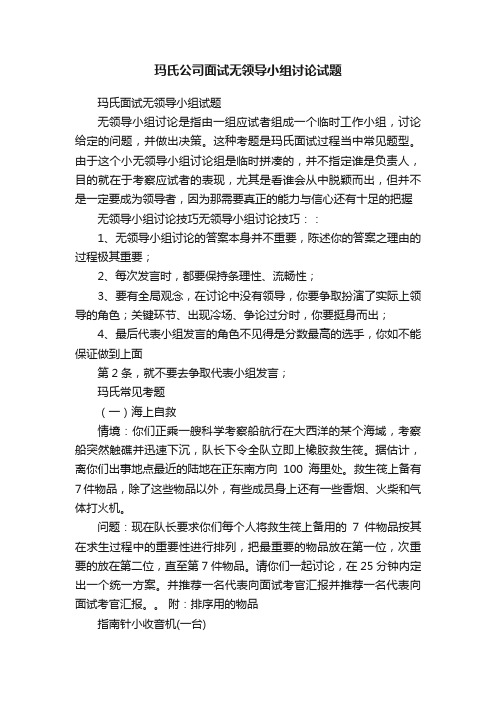
玛氏公司面试无领导小组讨论试题玛氏面试无领导小组试题无领导小组讨论是指由一组应试者组成一个临时工作小组,讨论给定的问题,并做出决策。
这种考题是玛氏面试过程当中常见题型。
由于这个小无领导小组讨论组是临时拼凑的,并不指定谁是负责人,目的就在于考察应试者的表现,尤其是看谁会从中脱颖而出,但并不是一定要成为领导者,因为那需要真正的能力与信心还有十足的把握无领导小组讨论技巧无领导小组讨论技巧::1、无领导小组讨论的答案本身并不重要,陈述你的答案之理由的过程极其重要;2、每次发言时,都要保持条理性、流畅性;3、要有全局观念,在讨论中没有领导,你要争取扮演了实际上领导的角色;关键环节、出现冷场、争论过分时,你要挺身而出;4、最后代表小组发言的角色不见得是分数最高的选手,你如不能保证做到上面第2条,就不要去争取代表小组发言;玛氏常见考题(一)海上自救情境:你们正乘一艘科学考察船航行在大西洋的某个海域,考察船突然触礁并迅速下沉,队长下令全队立即上橡胶救生筏。
据估计,离你们出事地点最近的陆地在正东南方向100海里处。
救生筏上备有7件物品,除了这些物品以外,有些成员身上还有一些香烟、火柴和气体打火机。
问题:现在队长要求你们每个人将救生筏上备用的7件物品按其在求生过程中的重要性进行排列,把最重要的物品放在第一位,次重要的放在第二位,直至第7件物品。
请你们一起讨论,在25分钟内定出一个统一方案。
并推荐一名代表向面试考官汇报并推荐一名代表向面试考官汇报。
附:排序用的物品指南针小收音机(一台)剃须镜航海图(一套)饮用水巧克力(二公斤)蚊帐二锅头酒(一箱)机油钓鱼工具(一套)救生圈驱鲨剂(一箱)压缩饼干(一箱)15米细缆绳30平方尺雨布一块(二)沙漠求生一、内容1、在炎热的八月,你乘坐的小型飞机在撒哈拉沙漠失事,机身严重撞毁,将会着火焚烧。
2、飞机燃烧前,你们只有十五分钟时间,从飞机中领取物品。
3、问题:在飞机失事中,如果你们只能从十五项物品中,挑选五项。
快速消费品公司管理培训生面试经验(玛氏强生欧莱雅飞利浦)
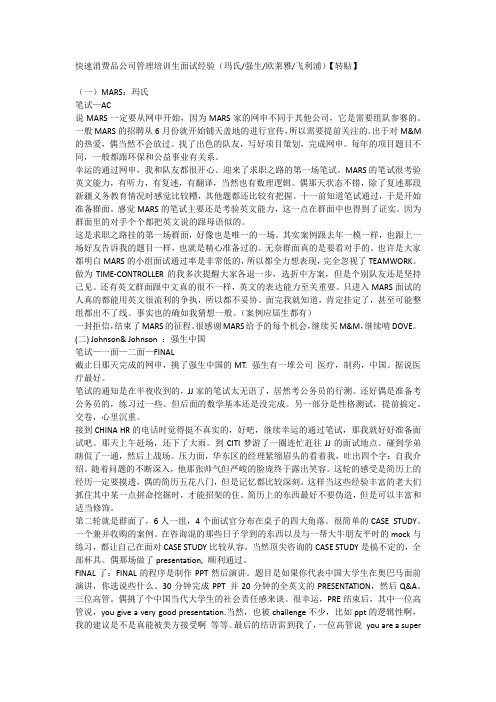
快速消费品公司管理培训生面试经验(玛氏/强生/欧莱雅/飞利浦)【转贴】(一)MARS:玛氏笔试—AC说MARS一定要从网申开始,因为MARS家的网申不同于其他公司,它是需要组队参赛的。
一般MARS的招聘从6月份就开始铺天盖地的进行宣传,所以需要提前关注的。
出于对M&M 的热爱,偶当然不会放过。
找了出色的队友,写好项目策划,完成网申。
每年的项目题目不同,一般都跟环保和公益事业有关系。
幸运的通过网申,我和队友都很开心。
迎来了求职之路的第一场笔试。
MARS的笔试很考验英文能力,有听力,有复述,有翻译,当然也有数理逻辑。
偶那天状态不错,除了复述那段新疆义务教育情况时感觉比较糟,其他题都还比较有把握。
十一前知道笔试通过,于是开始准备群面。
感觉MARS的笔试主要还是考验英文能力,这一点在群面中也得到了证实。
因为群面里的对手个个都把英文说的跟母语似的。
这是求职之路挂的第一场群面,好像也是唯一的一场。
其实案例跟去年一模一样,也跟上一场好友告诉我的题目一样,也就是精心准备过的。
无奈群面真的是要看对手的。
也许是大家都明白MARS的小组面试通过率是非常低的,所以都全力想表现,完全忽视了TEAMWORK。
做为TIME-CONTROLLER的我多次提醒大家各退一步,选折中方案,但是个别队友还是坚持己见。
还有英文群面跟中文真的很不一样,英文的表达能力至关重要。
只进入MARS面试的人真的都能用英文很流利的争执,所以都不妥协。
面完我就知道,肯定挂定了,甚至可能整组都出不了线。
事实也的确如我猜想一般。
(案例应届生都有)一封拒信,结束了MARS的征程。
很感谢MARS给予的每个机会,继续买M&M,继续啃DOVE。
(二) Johnson& Johnson :强生中国笔试—一面—二面—FINAL截止日那天完成的网申,挑了强生中国的MT. 强生有一堆公司医疗,制药,中国。
据说医疗最好。
笔试的通知是在半夜收到的,JJ家的笔试太无语了,居然考公务员的行测。
玛氏面试范本大全

玛氏面试范本大全八个面试无领导小组讨论经典问题1、废料处理问题背景在座的各位是ABC废料处理公司的项目执行小组,现在正负责为一家化工厂处理一批工业废料,任务是在限定日期之前把这些废料运输到一个指定的倾倒地区填埋。
该项目差不多通过环保局的批准。
在座各位最近听到消息说有人向环保局反映这批废料中可能含有一种专门的有毒物质,这种物质用通常的方法是无法检测出来的。
环保局正在考虑组建一个专门的小组使用专门的仪重视新对这批废料进行检验。
公司领导决定,让在座各位组成的执行小组赶在环保局重新检查之前倾倒这些废料。
因为假如废料被环保局禁止倾倒,按照公司与化工厂的协议,公司将进行赔偿,如此会给公司造成巨额的缺失,有可能导致公司倒闭。
同时项目执行小组的所有成员都将承担要紧的责任。
而假如现在就把这批废料处理掉,即使以后发觉里面含有有毒物质,公司也可不能受到任何处罚,因为差不多通过了环保局的批准。
任务要求每位小组成员第一利用用3分钟时刻认真阅读题目,然后利用25分钟时刻进行小组内部讨论,给出是否要在环保局进行调查之前将这些废料倒掉的一致的决策,以及你们将在决策后采取什么样的打算和行动。
达成一致意见后,请推选一名代表向公司决策层做2分钟的汇报。
2、面包销毁问题背景假设你是某面包公司的业务员。
现在公司派你去偏远地区销毁一卡车的过期面包〔可不能致命的,无损于躯体健康〕。
在行进的途中,刚好遇到一群饥饿的难民堵住了去路,因为他们坚信你所坐的卡车里有能吃的东西。
这时报道难民动向的记者也刚好赶来。
关于难民来说,他们确信要解决饥饿问题;关于记者来说,他是要报道事实的;关于你业务员来说,你是要销毁面包的。
现在要求你既要解决难民的饥饿问题,让他们吃这些过期的面包〔可不能致命的,无损于躯体健康〕,以便销毁这些面包,又不能让记者报到过期面包的这一事实?请问你将如何处理?说明:1、面包可不能致命。
2、不能贿赂记者。
3、不能损害公司形象。
任务要求每位小组成员第一利用用3分钟时刻认真阅读题目,然后利用25分钟时刻进行小组内部讨论,给出一致结论。
201605-MarsISC面试过程全记录
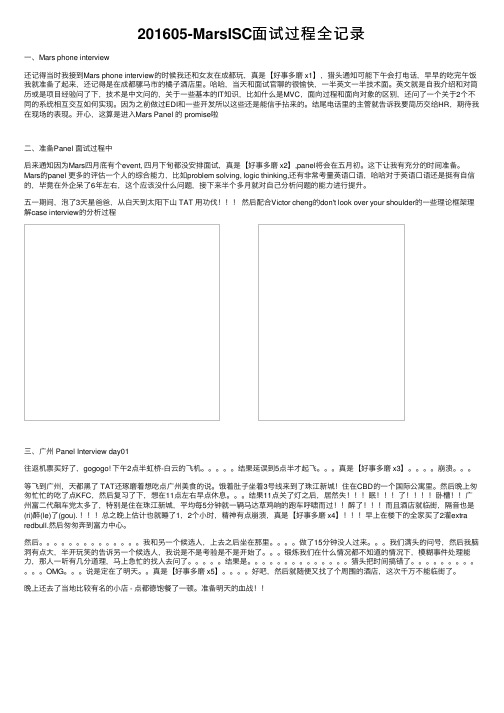
201605-MarsISC⾯试过程全记录⼀、Mars phone interview还记得当时我接到Mars phone interview的时候我还和⼥友在成都玩,真是【好事多磨 x1】,猎头通知可能下午会打电话,早早的吃完午饭我就准备了起来,还记得是在成都骡马市的橘⼦酒店⾥。
哈哈,当天和⾯试官聊的很愉快,⼀半英⽂⼀半技术⾯。
英⽂就是⾃我介绍和对简历或是项⽬经验问了下,技术是中⽂问的,关于⼀些基本的IT知识,⽐如什么是MVC,⾯向过程和⾯向对象的区别,还问了⼀个关于2个不同的系统相互交互如何实现。
因为之前做过EDI和⼀些开发所以这些还是能信⼿拈来的。
结尾电话⾥的主管就告诉我要简历交给HR,期待我在现场的表现。
开⼼,这算是进⼊Mars Panel 的 promise啦⼆、准备Panel ⾯试过程中后来通知因为Mars四⽉底有个event, 四⽉下旬都没安排⾯试,真是【好事多磨 x2】,panel将会在五⽉初。
这下让我有充分的时间准备。
Mars的panel 更多的评估⼀个⼈的综合能⼒,⽐如problem solving, logic thinking,还有⾮常考量英语⼝语,哈哈对于英语⼝语还是挺有⾃信的,毕竟在外企呆了6年左右,这个应该没什么问题,接下来半个多⽉就对⾃⼰分析问题的能⼒进⾏提升。
五⼀期间,泡了3天星爸爸,从⽩天到太阳下⼭ TAT ⽤功伐然后配合Victor cheng的don't look over your shoulder的⼀些理论框架理解case interview的分析过程三、⼴州 Panel Interview day01往返机票买好了,gogogo! 下午2点半虹桥-⽩云的飞机。
结果延误到5点半才起飞。
真是【好事多磨 x3】。
崩溃。
等飞到⼴州,天都⿊了 TAT还琢磨着想吃点⼴州美⾷的说。
饿着肚⼦坐着3号线来到了珠江新城!住在CBD的⼀个国际公寓⾥。
然后晚上匆匆忙忙的吃了点KFC,然后复习了下,想在11点左右早点休息。
我去年应聘玛氏的一些心得
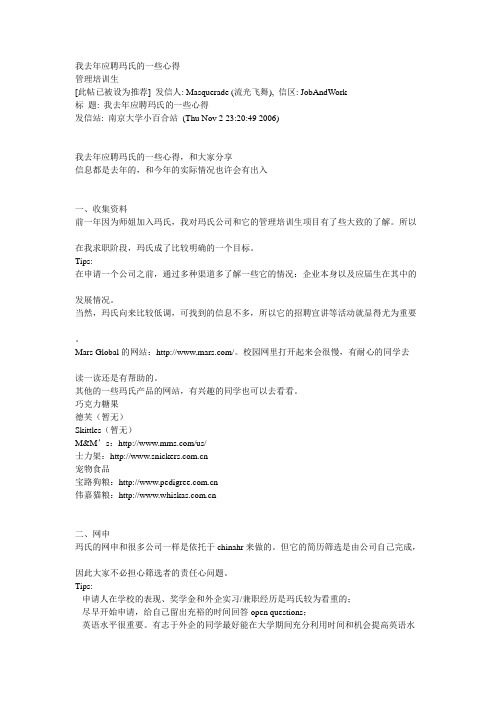
我去年应聘玛氏的一些心得管理培训生[此帖已被设为推荐] 发信人: Masquerade (流光飞舞), 信区: JobAndWork标题: 我去年应聘玛氏的一些心得发信站: 南京大学小百合站(Thu Nov 2 23:20:49 2006)我去年应聘玛氏的一些心得,和大家分享信息都是去年的,和今年的实际情况也许会有出入一、收集资料前一年因为师姐加入玛氏,我对玛氏公司和它的管理培训生项目有了些大致的了解。
所以在我求职阶段,玛氏成了比较明确的一个目标。
Tips:在申请一个公司之前,通过多种渠道多了解一些它的情况:企业本身以及应届生在其中的发展情况。
当然,玛氏向来比较低调,可找到的信息不多,所以它的招聘宣讲等活动就显得尤为重要。
Mars Global的网站:/。
校园网里打开起来会很慢,有耐心的同学去读一读还是有帮助的。
其他的一些玛氏产品的网站,有兴趣的同学也可以去看看。
巧克力糖果德芙(暂无)Skittles(暂无)M&M’s:/us/士力架:宠物食品宝路狗粮:伟嘉猫粮:二、网申玛氏的网申和很多公司一样是依托于chinahr来做的。
但它的简历筛选是由公司自己完成,因此大家不必担心筛选者的责任心问题。
Tips:- 申请人在学校的表现、奖学金和外企实习/兼职经历是玛氏较为看重的;- 尽早开始申请,给自己留出充裕的时间回答open questions;- 英语水平很重要。
有志于外企的同学最好能在大学期间充分利用时间和机会提高英语水平。
三、笔试玛氏的笔试是SHL的题目,考题难度不大,但时间很紧。
我没做过其他公司SHL的考试,所以无法比较。
但个人认为玛氏笔试比宝洁解难考试难度稍大。
Tips:- 考题分数理逻辑和阅读两部分。
建议大家在考前去SHL的网站上做些例题,熟悉题型,安排分配答题时间,会很有帮助。
- 实际题目的难度感觉比网站的例题难度大,要做好心理准备。
- 数学部分是中文题目,图表分析。
图表是打乱穿插的,会比较费时。
玛氏面试案例分析培训(Case-interview)

• Interpersonal skills • Communication skills • Organizational skills
Key Questions
Is the candidate relaxed and confident? Is the candidate engaging? Is the candidate a good listener? Is the candidate asking insightful, clarifying questions? Is the candidate good at organizing the information provided? Is the candidate good at developing a framework for analyzing the information? Is the candidate stating assumptions clearly? Is the candidate comfortable discussing the multifunctional aspects of the case? Is the candidate examining the organizational and cultural issues as well as the functional and strategic? Is the candidate approaching the problem at the right level of detail? Is the candidate thinking creatively? Is the candidate demonstrating analytical horsepower?
mars面经

【转载】玛氏,我们一路Suffer过来12.2-12.4去北京参加玛氏的终面AC,是抱着一种不知所措的心情搭上的飞往京城的飞机。
此次北京之行的收获不仅在于一个沉甸甸的结果,更多的是,在这短短三天内,我认识了一个曾未认识过的自己,收获了一个让我自己以及我的beloved的family和朋友都可以安心的我。
背景:这次进京,我不是一个可以轻松的可以高昂着头一笑而过的candidate。
我着实是带着压力去的。
而且这个压力是在我终面的前一晚戏剧性地达到了顶峰。
我的Job Hunting真正进行的只有三家:玛氏、太古和英博。
太古:暑期实习的地儿,原以为是很稳健的拿到全职Offer。
国庆期间,在正式招聘的网申都尚未截至时,我们8个实习生奔到香港直接参加了Final Interview。
然而之后结果一直未出。
拖到10月底,接到通知,公司决定给我加一轮太古航空的final面,同时并未告知我太古地产的结果。
11.2面完航空后,等了两周,在以为要出结果的时候,得到通知,说要等到12月初正式招聘全部结束后,给我答复。
(这中间夹杂了更为复杂的过程,若干。
省略。
)英博:因为对太古Offer的过于自信,导致基本没有备胎。
除去光荣地挂掉笔试的麦肯锡、宝洁、联合利华之外,我就没有再投其它公司了。
这时候急了,就抓起英博,认真对待。
前前后后历经一轮网申,两轮网上测试,四轮面试。
12.1号刚去上海参加完他家的终面,12.2就飞去北京了。
英博的结果也要几周之后出。
以上就是我去玛氏AC时的状态:只有两个已进行完毕的等待悬而未决的结果的“备胎”,一旦三家都挂掉,我就回家找个地儿窝着去了。
没退路的。
12.2从11月下旬开始,就来来回回在杭州上海之间做瞬时位移,很累。
身子累,心更累。
12.1面完英博终面,顶着星星赶回杭州。
第二天一早跳上去北京的飞机。
一路上,从出租,机场大巴,候机室到飞机,我一直在睡。
整个人的状态非常疲惫。
到了首都机场,颇为周折地从2号航楼折腾到3号楼,坐上公司来接我们的大巴。
- 1、下载文档前请自行甄别文档内容的完整性,平台不提供额外的编辑、内容补充、找答案等附加服务。
- 2、"仅部分预览"的文档,不可在线预览部分如存在完整性等问题,可反馈申请退款(可完整预览的文档不适用该条件!)。
- 3、如文档侵犯您的权益,请联系客服反馈,我们会尽快为您处理(人工客服工作时间:9:00-18:30)。
•Cost •Quality •Cycle Time •Technology
•Value Engineer. •Research •Development Timetable •Investment hurdle •Prototyping
MARS CASE STUDY TRAINING
The Case Interview
Why case interviews ?
Snapshots of Consulting Engagements
Simulate a “typical” situation between a client and a consultant
Recruiters look for three primary characteristics
Problem Problem solving solving
Assess if the candidate has aptitude for
Tolerance for Tolerance for ambiguity ambiguity
Supplier Power
• Number and size of suppliers • Switching costs/product differentiation • Availability of substitutes • Possibility of forward integration
Promotion
• What advertising medium is used to sell the product? • What is the most effective method of “getting the word out”?
Price
• How is this product priced? • How are its competitors priced?
The “Four Ps”
Product
• What are the product’s differentiating attributes? • Why does the consumer purchase this product?
Place (Distribution)
• How is the product distributed to consumers? • What new methods of distribution are coming available?
How effective is this product’s marketing campaign?
Porter’s Five Forces
Barriers To Entry
• Economies of scale • Capital costs • Cost advantage of existing competitors • Barriers to exit • Patents
The “Four Cs”
Market Positioning of XYZ Company
Costs • Break down the company’s cost structure — Fixed — Variable • Estimate the competitor’s cost structure • Understand trends in cost structures Customers • Segment the company’s customer base — New/existing — Loyal/ switchers • Examine company profitability by segment — How much do they purchase? — At what price? Competitors • Identify major competitors — Traditional — Unexpected substitutes • What are the competitor’s strengths and weaknesses — Profits — Costs • Investigate market share Channels • Identify relative channel leverage — Sources of advantage — Sustainability • Impact of channel strategies on market positioning
Market Rivalry
• Number and size of competitors • Industry growth rate • Product differentiation factors • Industry margins/pricing
Buyer Power
• Significance of the purchase relative to cost structure • Switching costs • Purchase volume • Threat of backward integration
Minimal skill sets a consultant uses daily
Communication Communication skills skills
Case interviews evaluate far more than a candidate’s functional and technical skills
• Unique packaging • “Superior cleaning power” • Affinity marketing — “cool people drink XX”
• Retail store • Warehouse store, Sam’s Club • Mail order • Internet/electronic distribution
• Newspaper versus TV versus radio ads • Retail placement — aisle-end displays • New media?
• Value pricing/ “Every Day Low Price” • Premium pricing • Price discrimination
•Costs (Labor, overhead, WIP, Capacity) •Process (Throughput, general flow, economies of scale, yield, best practice, utilization, asset base, technology)
• Strategic thinking skills
• Creativity skills • Analytical skills
TYPES OF CASE INTERVIEWS AND FRAMEWORKS
The Cost-Revenue Model
Profit Revenue Cost
(
Price
• Capital equipment • Land • Buildings
+
Variable
• Labor • Materials • Energy
)
• Customer segmentation — New/existing — Loyal/ switchers • Channel restrictions or temporary disturbances • Changing consumer demands
Substitutes
• Relative price/value of the substitute compared to industry’s product • Cost of switching to substitute • Buyers’ propensity to switch
Value Chain
Financial Analysis
• Estimate Future Cash Flow – Revenues - Costs • Estimate Discount Rates – Look at comparables • Attain Net Present Value (NPV) – Discount future cash flows at appropriate discount rate • Consider Other Synergies – Reasons for go ahead despite negative NPV
• Price discrimination • Changes in pricing structure • Viability of pricing over time • Discounts or couponing • Competitor’s pricing
X
Quantity
)—(
Fixed
•Research •Price elasticity •Promotion •Channels
•Response time •Size of sale force •Margins •Inventory turns •Enabling •Logistics •Agency systems •Level of support technology •Logistics network •Labor vs. in-house requirements •Structure of •Commission •Satisfaction network structure •Retention/attrition •Delivery/batch levels sizes levels •Volume vs. profit
